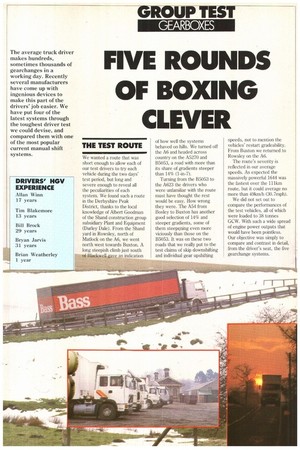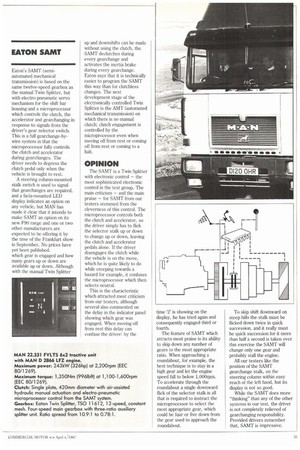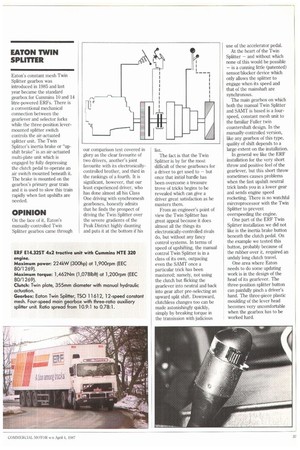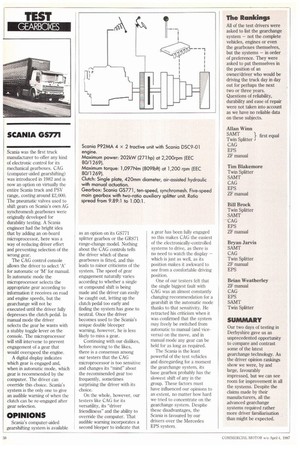FIVE ROUNDS OF BOXING CLEVER
Page 35

Page 36

Page 37

Page 38

Page 39

Page 40

If you've noticed an error in this article please click here to report it so we can fix it.
The average truck driver makes hundreds, sometimes thousands of gearchanges in a working day. Recently several manufacturers have come up with ingenious devices to make this part of the drivers' job easier. We have put four of the latest systems through the toughest driver test we could devise, and compared them with one of the most popular current manual shift systems.
THE TEST ROUTE
We wanted a route that was short enough to allow each of our test drivers to try each vehicle during the two days' test period, but long and severe enough to reveal all the peculiarities of each system. We found such a route in the Derbyshire Peak District, thanks to the local knowledge of Albert Goodman of the Shand construction group subsidiary Plant and Equipment (Darley Dale). From the Shand yard in Rowsley, north of Matlock on the A6, we went north west towards Buxton. A long steepish climb just south of Blackwell gave an indication of how well the systems behaved on hills. We turned off the A6 and headed across country on the A5270 and B5053, a road with more than its share of gradients steeper than 14% (1-in-7).
Turning from the B5053 to the A623 the drivers who were unfamiliar with the route must have thought the rest would be easy. How wrong they were. The A54 from Bosley to Buxton has another good selection of 14% and steeper gradients, some of them steepening even more viciously than those on the B5053. It was on these two roads that we really put to the test claims of skip downshifting and individual gear upshifting
speeds, not to mention the vehicles' restart gradeability. From Buxton we returned to Rowsley on the A6.
The route's severity is reflected in our average speeds. As expected the massively powerful 1644 was the fastest over the 111Im route, but it could average no more than 49km/h (30.7mph).
We did not set out to compare the performances of the test vehicles, all of which were loaded to 38 tonnes GCW. With such a wide spread of engine power outputs that would have been pointless. Our objective was simply to compare and contrast in detail, from the driver's seat, the five gearchange systems.
ZF MANUAL
There is nothing new about the manual gearchange system fitted to the ZF 16S-130 synchromesh gearbox which is the standard fitment on Daf s FT3600 DKZ. Dafs long gearlever is connected to the gearbox's selector cover by means of a tubular steel rod and linkages. The splitter control valve is air actuated.
The 'double H' shift pattern, with which range changes are executed by moving the whole lever from side to side, was introduced in 1972.
OPINION
Any manual gearchange system, whether for a synchromesh or constant mesh gearbox, can only be as good as the installation carried out by the chassis manufacturer. So both the criticism and the praise levelled at this gearbox may be considered to be directed equally at ZF and Daf. It must be emphasised that the Ecosplit is by no means ZF's latest offering, so it is not too surprising that it came well down the list of most of the test drivers' rankings, compared with much more recently developed shift systems. Nevertheless one of our test drivers, significantly the least experienced, unashamedly puts the ZF in the Daf 3600 firmly at the top of his list. He says: "Being able to select a gear in a conventional manner, and to be in complete control over the clutch and the speed of engagement, gives me a reassuring feeling of being in full control," While understanding what lies behind that comment — driving the Daf after the other vehicles gives the same sort of feeling as flopping into a battered but comfortable old armchair after a day at the Ideal Home Exhibition — the other drivers feel that the system's disadvantages heavily outweigh that cosy familiarity. Winn Blakemore and Brock all strongly dislike the bias spring which in high range holds the lever in the 7/8 gate rather than the 5/6 gate, which would be much more helpful. The major disadvantage of any manual shift system compared with an electronic set-up — lever effort and the distance the lever has to be moved on a multi-speed gearbox — are emphasised on the Daf by the lever length and the intensely irritating fact that eighth gear cannot be engaged without the lever rubbing against the driver's seat.
Most of our drivers are unimpressed with the double H range-change shift system, seeing little merit in it compared with a simple separate switch, like that used by Volvo for example. We do feel, however, that it could be improved considerably by some form of dashboard display to indicate whether high or low range and split are engaged.
We are all agreed that the main advantage of the manual shift ZF in the Daf compared with the others in this test is that almost any competent HGV driver could be put into it without any special instruction and manage at least reasonably well. Given the claims made for other, more advanced systems, we find that surprising.
EATON SAMT
Eaton's SAMT (semiautomated mechanical transmission) is based on the same twelve-speed gearbox as the manual Twin Splitter, but with electro-pneumatic servo mechanism for the shift bar housing and a microprocessor which controls the clutch, the accelerator and gearchanging in response to signals from the driver's gear selector switch. This is a full gearchange-bywire system in that the microprocessor fully controls the clutch and accelerator during gearchanges. The driver needs to depress the clutch pedal only when the vehicle is brought to rest.
A steering column-mounted stalk switch is used to signal that gearchanges are required, and a facia-mounted LED display indicates an option on any vehicle, but MAN has made it clear that it intends to make SAMT an option on its new F90 range and one or two other manufacturers are expected to be offering it by the time of the Frankfurt show in September. No prices have yet been published.
which gear is engaged and how many gears up or down are available up or down. Although with the manual Twin Splitter up and downshifts can be made without using the clutch, the SAMT declutches during every gearchange and
activates the inertia brake during every gearchange. Eaton says that it is technically easier to program the sAmT this way than for clutchless changes. The next development stage of the electronically controlled Twin Splitter is the AMT (automated mechanical transmission) on which there is no manual clutch; clutch engagement is controlled by the microprocessor even when moving off from rest or coming off from rest or corning to a halt.
OPINION
The SAMT is a Twin Splitter with electronic control — the most sophisticated electronic control in the test group. The main criticism — and the main praise — for SAMT from our testers stemmed from the cleverness of this control. The microprocessor controls both the clutch and accelerator, so the driver simply has to flick the selector stalk up or down to change up or down, leaving the clutch and accelerator pedals alone. If the driver disengages the clutch while the vehicle is on the move, which he is quite likely to do while creeping towards a hazard for example, it confuses the microprocessor which then selects neutral.
This is the characteristic which attracted most criticism from our testers, although several also commented on the delay in the indicator panel showing which gear was engaged. When moving off from rest this delay can confuse the driver: by the time '2' is showing on the display, he has tried again and consequently engaged third or fourth.
The feature of SAMT which attracts most praise is its ability to skip down any number of gears to the most appropriate ratio, When approaching a roundabout, for example, the best technique is to stay in a high gear and let the engine speed fall to below 1,000rptn. To accelerate through the roundabout a single downward flick of the selector stalk is all that is required to instruct the microprocessor to select the most appropriate gear, which could be four or five down from the gear used to approach the roundabout. To skip shift downward on steep hills the stalk must be flicked down twice in quick succession, and it really must be quick succession for it more than half a second is taken over this exercise the SAMT will change only one gear and probably stall the engine.
All our testers like the position of the SAMT gearchange stalk, on the steering column within easy reach of the left hand, but its display is not so good.
While the SAMT does more "thinking" than any of the other systems in our test, the driver is not completely relieved of gearchanging responsibility. Provided drivers remember that, SAMT is impressive.
ZF ECOSPLIT
Mercedes-Benz unveiled its EPS (originally electropneumatic shift, now electronic power shift) system in 1985 and surprised some observers by making it standard equipment, rather than an option, on its 1986 '35 and '44 models. In the UK these are designated Powerliner models.
The gearbox on which the EPS system is fitted is ZF's 16-speed Ecosplit. The standard manual gearlever is replaced by the EPS shift unit which looks almost identical to a conventional lever, but is in fact an electrical switch.
There is no mechanical connection between the EPS lever and the gearbox. Pneumatic valves on the gearbox shift ratios in response to signals from the system's microprocessor. Clutch control is conventional air-assisted hydraulic, and splitter shifts are controlled by a switch on the front of the lever, as on a conventional ZF box. The EPS facia display panel indicates which gear has been selected and whether the splitter is in high or low. Any faults in the electronic system are identified by a coded digital display.
OPINION
None of the drivers rated EPS highly. Its highest ranking is third — in Brian Weatherley's list — while Bryan Jarvis puts it at the bottom of his list. Much of the criticism of the EPS system could be summarised as "not going far enough". In particular several testers mention the lack of indication of which gears could be selected, up or down at a given road speed. By contrast the clarity and position of the gear display is well liked, however, and other manufacturers could do well to follow the Mercedes example here, particularly regarding the useful high/low • split indicator.
Like every driver we know who tries EPS for the first time, Jarvis and Weatherley found they were tending to use too much effort at the lever, and both were caught out occasionally by the upshifts forward/downshifts back sequence, which at first seems unnatural.
Both these drivers also complain of being unable to skip gears when downchanging, despite closely following the instruction not to attempt a "block change" using the button on the front of the lever until engine speed falls to 1,050rpm or less. Our other three drivers find that the skip shifting button did work properly, but none likes this part of the system. We wonder how it would perform with less engine power and torque.
On the credit side, several of our testers say that compared with SAMT, they like to have full clutch control as on the Mercedes, and they like the lack of effort required to shift gear with EPS, compared with a manual shift ZF gearbox. One, who has clearly been noting Mercedes replacement engine prices, says: "It is reassuring to know that the engine cannot be overspeeded."
EATON TWIN SPLITTER
Eaton's constant mesh Twin Splitter gearbox was introduced in 1985 and last year became the standard gearbox for Cummins 10 and 14 litre-powered ERFs. There is a conventional mechanical connection between the gearlever and selector forks while the three-position levermounted splitter switch controls the air-actuated splitter unit. The Twin Splitter's inertia brake or "upshift brake" is an air-actuated multi-plate unit which is engaged by fully depressing the clutch pedal to operate an air switch mounted beneath it. The brake is mounted on the gearbox's primary gear train and it is used to slow this train rapidly when fast upshifts are needed.
OPINION
On the face of it, Eaton's manually-controlled Twin Splitter gearbox came through our comparison test covered in glory as the clear favourite of two drivers, another's joint favourite with its electronicallycontrolled brother, and third in the rankings of a fourth. It is significant, however, that our least experienced driver, who has done almost all his Class One driving with synchromesh gearboxes, honestly admits that he finds the prospect of driving the Twin Splitter over the severe gradients of the Peak District highly daunting and puts it at the bottom if his list.
The fact is that the Twin Splitter is by far the most difficult of these gearboxes for a driver to get used to — but once that initial hurdle has been overcome a treasure trove of tricks begins to be revealed which can give a driver great satisfaction as he masters them.
From an engineer's point of view the Twin Splitter has great appeal because it does almost all the things its electronically-controlled rivals do, but without any fancy control systems. In terms of speed of upshifting, the manual control Twin Splitter is in a class of its own, outpacing even the SAMT once a particular trick has been mastered; namely, not using the clutch but flicking the gearlever into neutral and back into gear after pre-selecting an upward split shift. Downward, clutchless changes too can be made astonishingly quickly, simply by breaking torque in the transission with judicious use of the accelerator pedal.
At the heart of the Twin Splitter — and without which none of this would be possible — is a cunning little (patented) sensoriblocker device which only allows the splitter to engage when its speed and that of the mainshaft are synchronous.
The main gearbox on which both the manual Twin Splitter and SAMT is based is a fourspeed, constant mesh unit to the familiar Fuller twin countershaft design. In the manually-controlled version, like any gearbox of this type, quality of shift depends to a large extent on the installation.
In general we like the ERF installation for the very short throw and positive feel of the gearlever, but this short throw sometimes causes problems when the fast upshift neutral trick lands you in a lower gear and sends engine speed rocketing. There is no watchful mircroprocessor with the Twin Splitter to prevent overspeeding the engine.
One part of the ERF Twin Splitter installation we did not like is the inertia brake button beneath the clutch pedal. On the example we tested this button, probably because of the rubber over it, required an unduly long clutch travel.
One area where Eaton needs to do some updating work is in the design of the head of its gearlever. The three-position splitter button can painfully pinch a driver's hand. The three-piece plastic moulding of the lever head becomes very uncomfortable when the gearbox has to be worked hard.
SCAN1A GS771
Scania was the first truck manufacturer to offer any kind of electronic control for its mechanical gearboxes. CAG (computer-aided gearshifting) was introduced in 1982 and is now an option on virtually the entire Scania truck and PSV range, costing around 22,000. The pneumatic valves used to shift gears on Scania's own AG synchromesh gearboxes were originally developed for durability testing. A Scania engineer had the bright idea that by adding an on-board microprocessor, here was a way of reducing driver effort and preventing selection of the wrong gear,
The CAG control console allows the driver to select 'A' for automatic or 'M' for manual. In automatic mode the microprocessor selects the appropriate gear according to information it receives on road and engine speeds, but the gearchange will not be executed until the driver fully depresses the clutch pedal. In manual mode the driver
selects the gear he wants with a stubby toggle lever on the console. The microprocessor will still intervene to prevent engagement of a gear that would overspeed the engine.
A digital display indicates which gear is engaged and, when in automatic mode, which gear is recommended by the computer. The driver can override this choice. Scania's system is the only one to give an audible warning of when the clutch can be re-engaged after gear selection.
OPINIONS
Scania's computer-aided gearshifting system is available as an option on its GS771 splitter gearbox or the GR871 range-change model. Nothing about the CAG controls tells the driver which of these gearboxes is fitted, and this leads to minor criticisms of the system. The speed of gear engagement naturally varies according to whether a single or compound shift is being made and the driver can easily be caught out, letting up the clutch pedal too early and finding the system has gone to neutral. Once the driver becomes used to the Scania's unique double bleeeper warning, however, he is less likely to miss a gear.
Continuing with our dislikes, before moving to the likes, there is a consensus among our testers that the CAG microprocessor is too sensitive and changes its "mind" about the recommended gear too frequently, sometimes surprising the driver with its choice.
On the whole, however, our testers like CAG for its versatility, its "driver friendliness'' and the ability to override the computer. That audible warning incorporates a second bleeper to indicate that a gear has been fully engaged so this makes CAG the easiest of the electronically-controlled systems to drive, as there is no need to watch the display — which is just as well, as its position makes it awkward to see from a comfortable driving position.
One of our testers felt that the single biggest fault with CAG was an almost constantly changing recommendation for a gearshift in the automatic mode thanks to that sensitivity. Fle retracted his criticism when it was confirmed that the system may freely be switched from automatic to manual (and viceversa) on the move, and in manual mode any gear can be held for as long as required.
The Scania is the least powerful of the test vehicles and disregarding for a moment the gearchange system, its base gearbox probably has the slowest shift of any in the group. These factors must have influenced our opinions to an extent, no matter how hard we tried to concentrate on the gearchange system. Despite these disadvantages, the Scania is favoured by our drivers over the Mercedes EPS system.




















































































